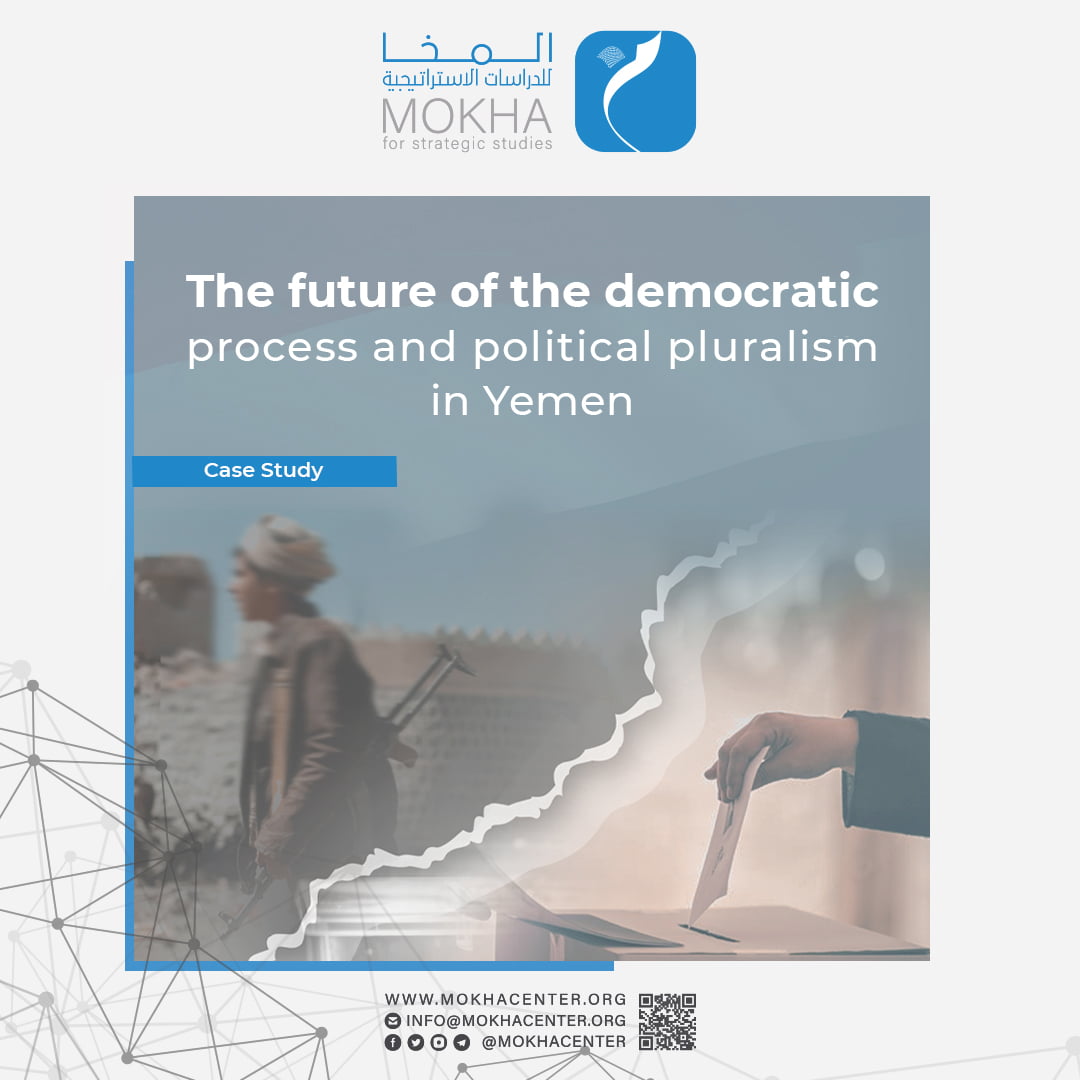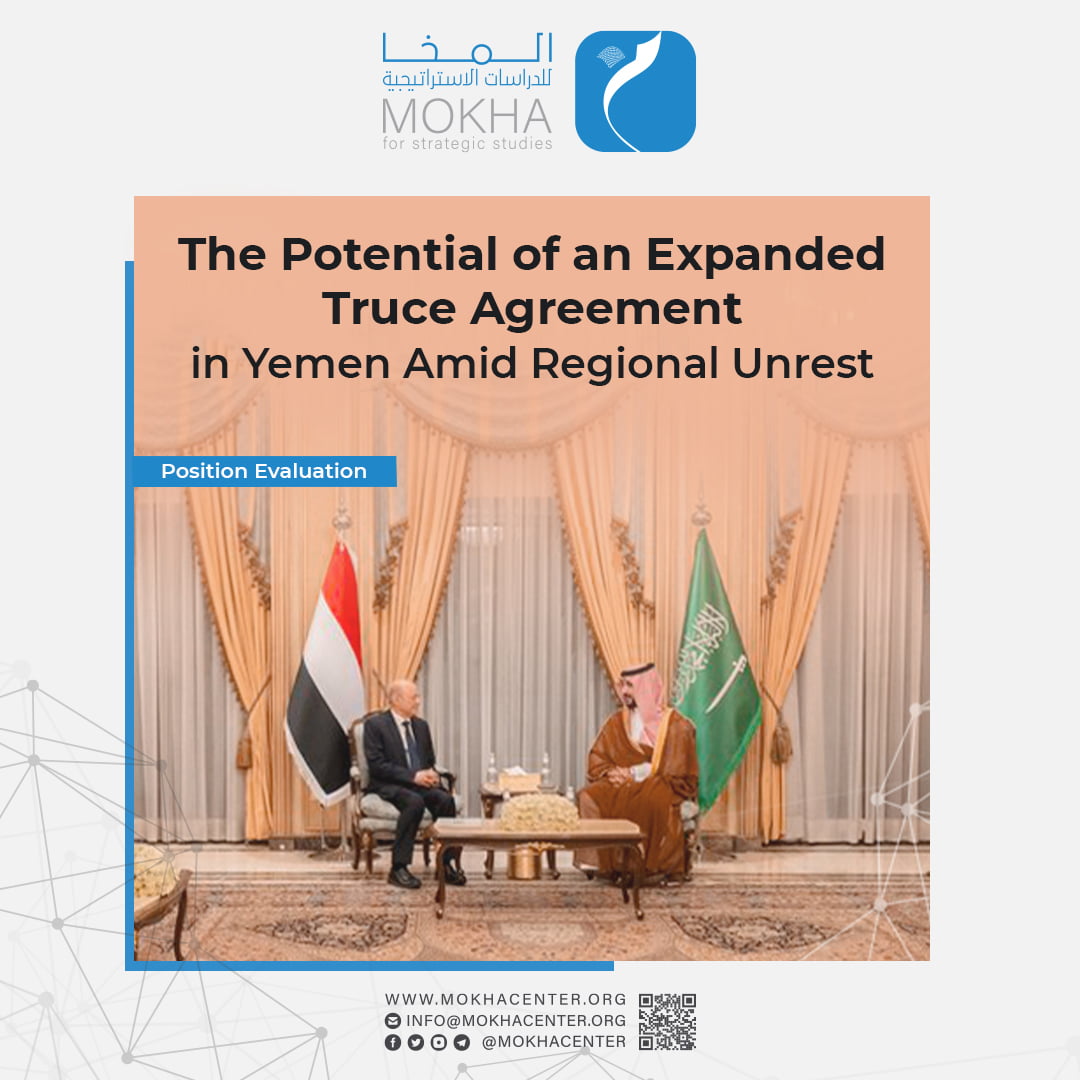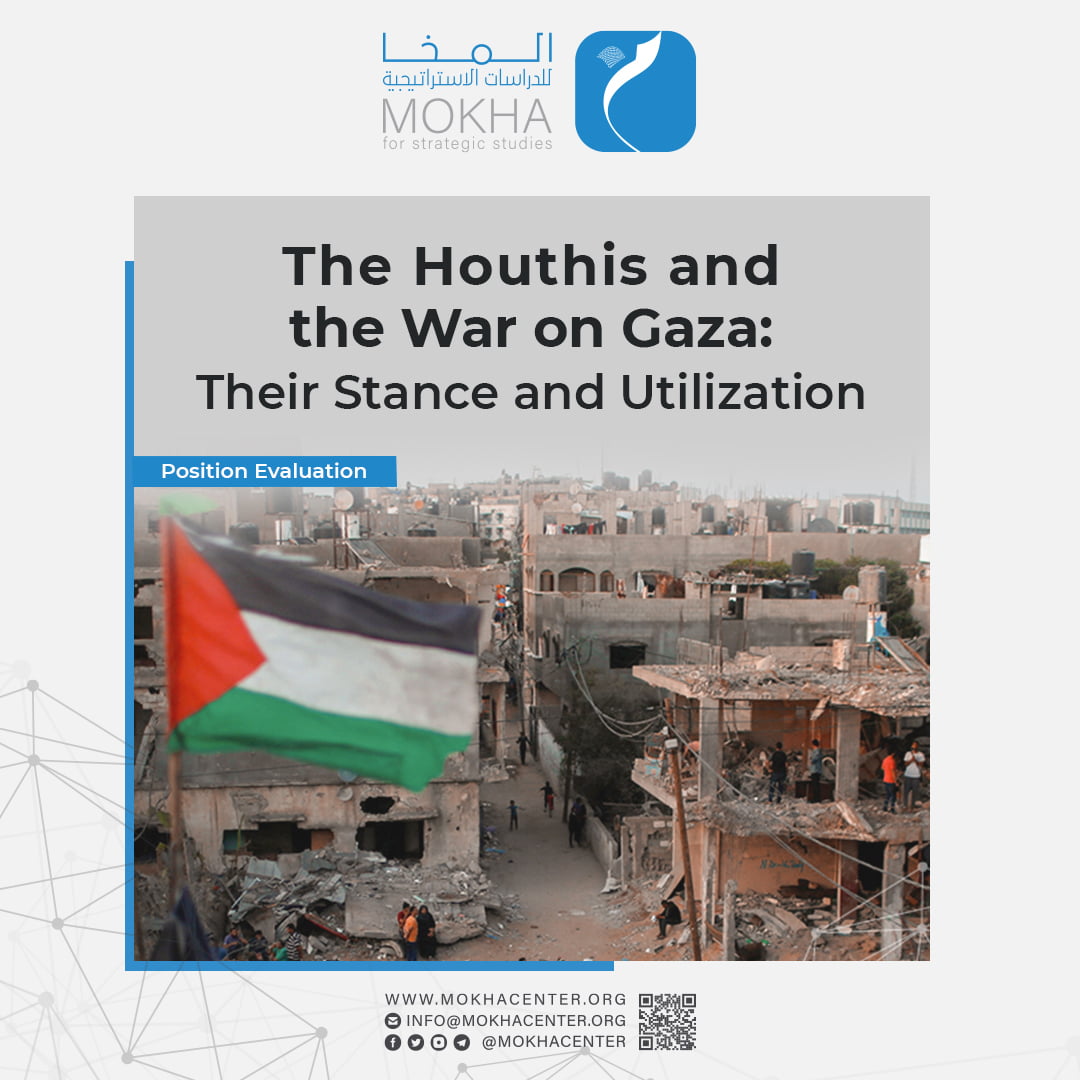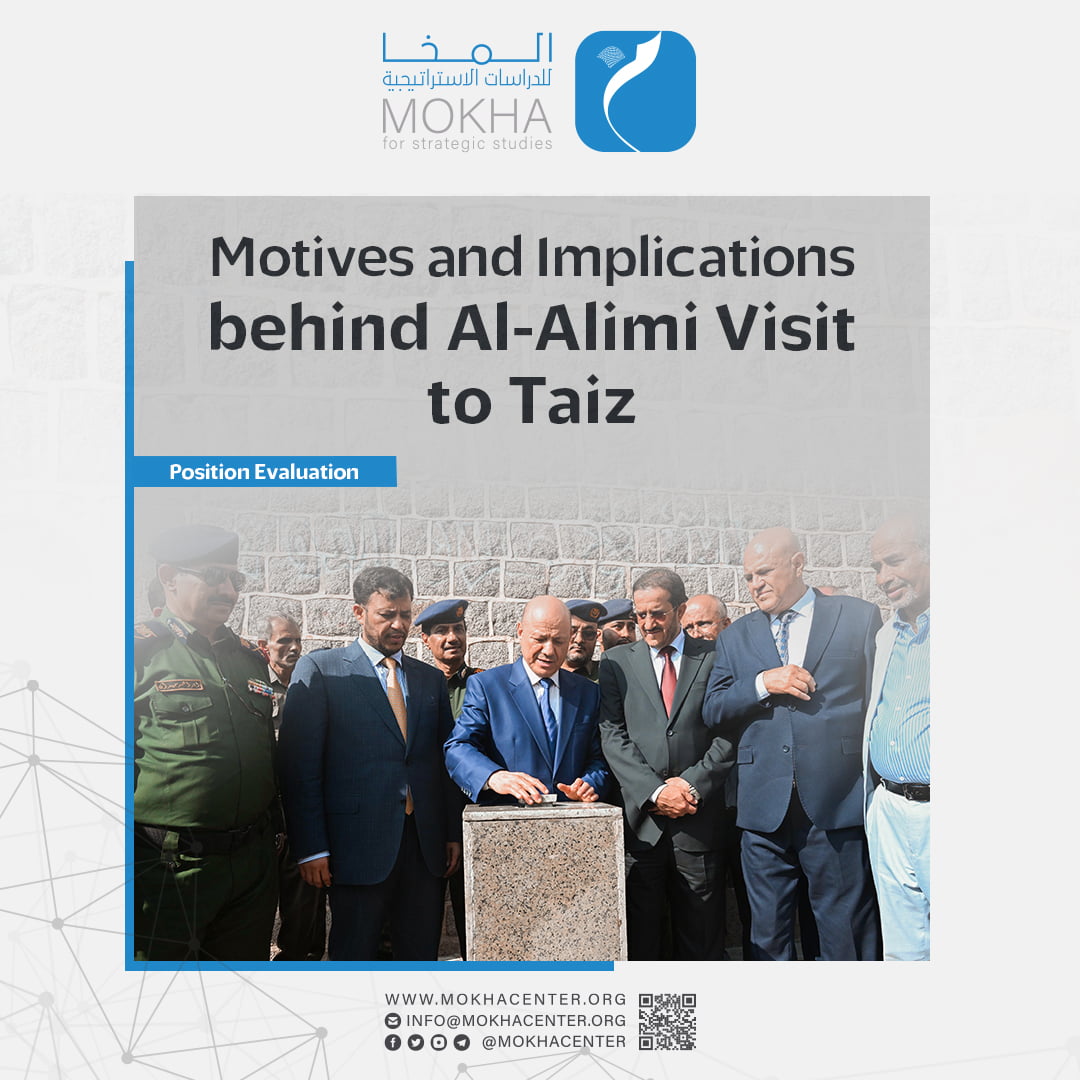Drivers Contributing to the Ongoing Armed Conflict in Yemen
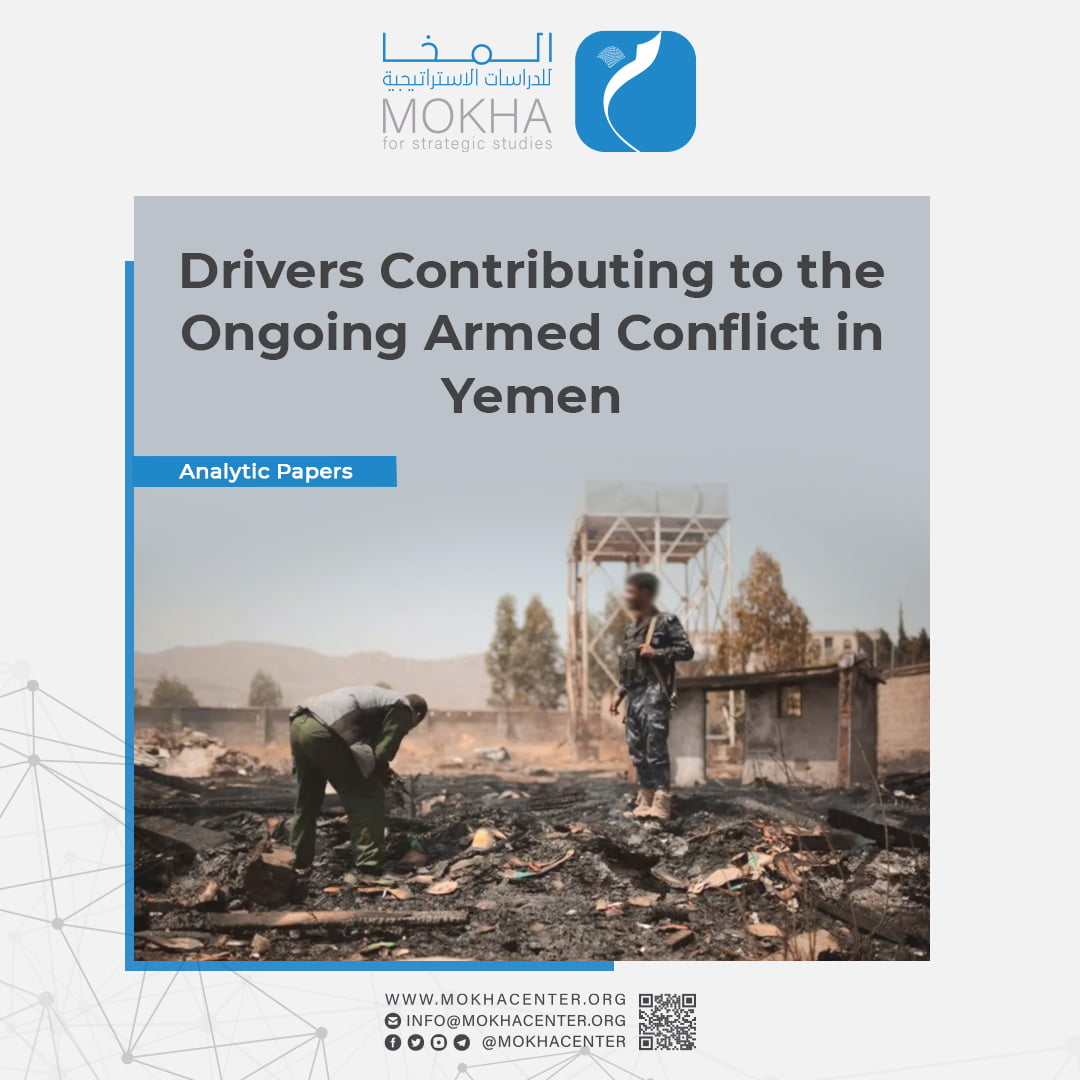
| Getting your Trinity Audio player ready... |
Abstract
Ending the armed conflict in Yemen appears far-fetched due to various factors driving its
continuation. This research paper will explore and analyze these drivers, starting with the
extremist ideology of the Houthi group. Their ideology, rooted in divine selection, aims to
control governance and society by fueling armed conflict and seizing leadership positions in
civil, security and military institutions. The group is determined to not pursue a comprehensive
political settlement until they dominate oil and gas resources, and they rely on Iran for military,
political, financial and media support, aligning with Iran’s regional dominance strategy.
Another driver is the weakness of the legitimate, internationally recognized authority. This
authority has failed to establish good governance in areas under its control, fulfill citizen needs
and overcome internal divisions. The Presidential Leadership Council, formed over a year and a
half ago, still struggles with division, clashes and weak consensus on critical issues, like Yemen’s
unity and resource distribution, hindering unity of command over military and security forces.
Iran’s strategic vision for Yemen, aiming to dominate the region, is another significant driver.
Iran sees Yemen as part of its strategic depth, expanding its influence through the Houthis in
vital areas, like the Red Sea coast and Bab al-Mandab. The Houthis have tipped the balance
against regional opponents, like Saudi Arabia, prompting Iran to continue supporting the
conflict.
Lastly, regional and international competition for dominance over Yemen and its strategic
location is a key driver. Yemen’s control over the Bab al-Mandab Strait and its proximity to
crucial maritime regions attract international and regional powers seeking control. This has led
to the involvement of international powers and regional actors on Yemen’s coasts and islands,
fueling the conflict’s continuation.
Introduction
After the Arab Spring in Yemen in February 2011, widespread financial and administrative
corruption, along with a struggling economy, led to large protests demanding the removal of
the ruling regime. Despite efforts to resolve the conflict through The Gulf Initiative, which led to
the transfer of power to Vice President Abd Rabbuh Mansour Hadi, the unrest continued. The
Houthi group participated in a national dialogue conference but also took military action,
expanding from their stronghold in Saada Governorate to neighboring regions, like Al-Jawf and
Hajjah. With a weak central state and dissatisfaction with the Government of National Accord
and President Hadi, along with former president Ali Abdullah Saleh’s ambitions to return to
power, the group seized the opportunity to escalate militarily. On September 21, 2014, they
stormed the capital, Sana’a, overthrowing government institutions and seizing control of army
and security camps. From there, they aimed to conquer other governorates and regions of
Yemen.
This event led to a bloody armed conflict, which continues today and has gained significant
regional and international attention. Iranian officials claim that Iran now controls four Arab
capitals and assert that the Houthis are a product of the Iranian revolution. On March 12, 2015,
the group held a military parade and maneuvers involving thousands of fighters and various
weapons, including heavy weaponry seized from Yemeni army camps. These maneuvers
occurred in the Al-Baqa’ area in Saada Governorate, near the Saudi border. The Houthi militia,
along with forces loyal to former President Saleh, also carried out raids on the presidential
palace in the city of Aden after President Hadi fled there from Sana’a.
These events and maneuvers prompted the Arab Coalition, led by Saudi Arabia, to intervene on
March 26, 2015, announcing the “Decisive Storm” military operation. The intervention was
based on President Hadi’s request to Gulf Cooperation Council leaders to militarily remove the
coup and restore legitimacy. This led President Hadi to flee via the Sultanate of Oman to
Riyadh, the Saudi capital, where he established the next headquarters for him and his
internationally recognized government.
1) The First Driver – The Extreme Ideology of the Houthi Group and its Aim to Dominate
Society:
The Houthi group bases its authority on an extreme ideological framework that claims exclusive
rights to power and governance, tracing back to the lineage of Al-Hassan and Al-Hussein, the
sons of Imam Ali bin Abi Talib, following the Prophet Muhammad’s passing. This belief,
formalized in a document issued by the Houthi group on February 13, 2012, asserts a divine
mandate for their leadership until the Day of Judgment.
This radical ideology is the main reason for the ongoing armed conflict, shaping the foundation
of the Houthi group’s emergence and influencing its policies in governing the state and society.
However, various associated factors also contribute to this situation, including:
• Sectarian political agenda: The group initiates armed conflict using ideological pretexts:
According to the spokesperson of the Yemeni Teachers Syndicate, the Houthis have
changed the government curriculum in areas they control, introducing a sectarian bias to
perpetuate discrimination. This includes showing favoritism toward the Houthis and their
lineage over other Yemenis, ultimately undermining human rights, like freedom, justice and
equal citizenship. They have offered sectarian religious justifications that portray war as a
holy struggle. Additionally, the Houthis compelled public employees and influential figures
to take part in cultural programs where they undergo a process of ideological re-education.
These courses indoctrinate them into Houthi beliefs, reshaping their views and urging them
to support and spread the group’s slogans and ideas.
• Seizing leadership positions within the state’s civil, military and security institutions:
The Houthi group uses an exclusionary approach that sidelines qualified individuals not
aligned with Hashemites, who are loyal to the group. They appoint replacements based on
family connections, followed by loyal supporters from outside the dynasty, ensuring
complete control over political and administrative decision-making in Yemen. Inequality,
along with feelings of unfairness and exclusion, serves as a driving force behind the ongoing
armed conflict.
Expansion and control: The Houthi group prioritizes seizing Ma’rib Governorate,
which houses the Ministry of Defense headquarters, the Chief of Staff’s office, and
valuable oil and gas fields. Their objective is to extend their influence toward the oil
and gas reserves in Shabwa and Hadhramaut. As a result, they are escalating military
pressure on Ma’rib, the site of some of Yemen’s most intense battles. It appears that
the group aims to secure dominance over the oil and gas fields in Ma’rib before
engaging in a comprehensive and sustainable political settlement. This strategy
would grant them control over the primary sources of power and wealth across
many regions of Yemen.
Close ties with Iran: The Houthi group developed complex and close relations with
Iran, resulting in a significant dependency on Iran across military, political, financial,
media and logistical dimensions. Numerous reports suggest that Iran, through its
ambassador Hassan Erloo, has exerted influence over strategic decisions made by
the Houthis. The Houthi group openly acknowledges this relationship, using it to
justify Iranian intervention and the involvement of Lebanese Hezbollah in the
Yemeni conflict.
Balance of power in favor of the Houthi group: Their military strength significantly
surpasses that of their adversaries, leading to a sense of arrogance and inflexibility in
their actions. Critics point out the group’s history of failing to adhere to agreements,
making it challenging to reach a political resolution. Under these circumstances, it’s
unlikely that the Houthi group’s opponents will accept any proposed settlements
that could result in a fragile peace. Consequently, any unjust settlement would carry
the risk of ongoing armed conflict.
2) The Second Driver – The Weakness of The Legitimate Government and The Contradiction
of Its Components:
The weakness of the legitimate government and the contradictions among its components
serve as a driver in extending the conflict. While the Houthi group demonstrates strength, unity
and territorial gains, the internationally recognized government faces challenges in fulfilling its
constitutional obligations.
Following the departure of former President Abd Rabbuh Mansour Hadi from Yemen, a non-
combative approach was adopted to restore the state and mostly relied on the intervention of
the Arab coalition. However, this approach allowed the expansion of the Houthi control over
more territories while weakening the legitimate government’s influence, particularly in areas
under its authority allowing the Southern Transitional Council, which is supported by the UAE,
to actively work toward establishing a separatist state in southern Yemen.
At the same time, state institutions have struggled to meet basic citizen needs, including regular
salary payments, essential services, such as electricity, water, healthcare and education, and
addressing security concerns, in areas under nominal government control.
As a result, public trust in the legitimate government started to decline, jeopardizing the
widespread political support it once enjoyed. The failure to establish effective governance
models in its controlled areas has further diminished its credibility among Yemenis, except for
limited exceptions in provinces, such as Ma’rib and Hadhramaut. These factors collectively
contribute to the perception of the legitimate government as ineffective and make the conflict
in Yemen worse.
The legitimacy of the government further weakened as internal divisions widened, giving rise to
parallel entities with significant power and influence on the ground. Despite the Riyadh
Agreement signed between the legitimate government and the STC on November 5, 2019,
which aimed to resolve internal strife and establish a national unified government, the STC
consolidated its authority across most cities and governorates in southern Yemen.
Despite the agreement’s provisions to end power struggles and unify state institutions, the STC
emerged as the de facto authority, especially in Aden, the temporary capital. The STC’s
aggressive actions against government forces forced many liberated areas in southern Yemen
to fall out of the government’s control. As a result, the STC assumed sovereign functions
typically held by the government and maintained distinct military formations operating
independently of the Yemeni armed forces.
These formations openly identify as separatist forces, distinct from the Republic of Yemen, and
maintain close ties with the United Arab Emirates (UAE), which exercises control over Yemen’s
ports and coasts, extending from Mukalla in the east to Bab al-Mandab in the west.
In April 2022, the Presidential Leadership Council was established to replace former President
Hadi and his deputy, aiming to represent the diverse components of legitimacy in Yemen. The
council comprised a president and seven representatives from various political and military
factions, reflecting the discordant and conflicting interests influenced by Saudi Arabia and the
UAE.
Despite more than a year and a half since its formation, the council remains characterized by
division and internal conflict among its members. Each faction within the council holds its
authority, leading to a lack of cohesion and a shared strategy on crucial issues, such as Yemen’s
unity and the management of power and resources, including control over oil, gas, ports, vital
facilities and local administration in governorates and cities under its jurisdiction.
Instead of consolidating all military and security forces under the unified command of the
Ministry of Defense, the Chief of Staff and the Ministry of Interior, and under the authority of
the council president as the Supreme Commander of the Armed Forces, new military units
were established under different names. In January 2023, Dr. Rashad Al-Alimi, chairman of the
Presidential Leadership Council (who does not possess his own military forces, unlike other
council members), declared the formation of a new military unit named the “Homeland Shield
Forces.” This unit operates directly under his command and serves as a reserve for the
Supreme Commander of the Armed Forces. In light of the council’s inability to achieve unity of
command and control over the forces and armed formations of its components, military
confrontations will likely erupt between these forces and formations.
Additionally, the persistent discord among the components of the Presidential Leadership
Council, coupled with its inability to function cohesively, has further undermined the state’s
authority. This is exemplified by the marginalization of the parliament, the last constitutionally
elected popular institution. Instead, a non-elected body, the “Consultation and Reconciliation
Commission,” was appointed and granted powers that traditionally fall under parliament’s
purview. As a result, the parliament, marginalized in the past, has now become nearly
incapacitated in fulfilling its constitutional duties as outlined in the Republic of Yemen’s
Constitution.
These developments have collectively weakened the legitimacy of the governing authority —
the presidency, the parliament and the government. A significant portion of Yemeni citizens
now perceive this government as incapable of ending the coup and restoring legitimacy.
Instead, it is perceived as severely deficient in preserving the unity, national sovereignty and
territorial integrity of the Republic of Yemen.
3) The Third Driver: Iran’s Strategic Vision for Yemen in its Project of Hegemony Over the
Region:
The power that Iran has accumulated over the past decades has enabled it to strengthen its
regional intervention tools based on concepts ingrained in its geopolitical framework, namely
exporting the revolution and strategic depth. In his speech, which is considered a guiding
document for all Iranian foreign policy-making institutions, the Supreme Leader of the Iranian
Revolution, Ali Khamenei, during his meeting with Iranian diplomats, outlined six factors
shaping foreign policy in the forthcoming phase. Among these factors is the strengthening of
the allied and pro-Iranian governments and factions, alongside the expansion of the nation’s
strategic depth.
In this context, Iranian leaders see Yemen as an essential part of their country’s strategic depth.
The current Iranian president, Ibrahim Raisi, emphasized this during his election campaign. Ali
Reza Zakani, a parliamentarian close to Khamenei, also referred to the Yemeni capital (Sana’a),
following its capture by the Houthi group, as the fourth Arab capital linked to Iran. This
viewpoint was echoed by former Minister of Intelligence, Haider Moslehi, who described the
Houthis in Yemen as a result of the Iranian revolution. Additionally, Deputy Commander of the
Revolutionary Guard, General Hussein Salami, stated that “Ansar Allah” in Yemen had become a
significant player in the region’s dynamics, akin to “Hezbollah” in Lebanon.
Based on this strategic viewpoint, Iran is actively supporting the ongoing conflict in Yemen by
providing the Houthi group with diverse forms of military, political, financial, media and
logistical aid. This support aims to facilitate the group’s control over Yemen and its strategic
location and to guide them toward establishing a political governance model aligned with the
institutions of the Iranian regime. Furthermore, Iran’s strategy aims to promote the Houthi
group as a model that inspires and encourages the spread of the revolution to other areas in
the region.
The Houthis have effectively demonstrated their important role in advancing Iran’s hegemonic
strategy. Through their actions, Iranian influence has expanded into crucial new areas, and Iran
has established a military presence along the Red Sea coast and near Bab al-Mandab. This
expansion was acknowledged by the current commander of the Revolutionary Guard, General
Hussein Salami, who stated, “Today, Iran’s reach extends far beyond what geographical maps
depict.”
Additionally, the Houthis have helped shift the balance of power in Iran’s favor against its
regional adversaries. During heightened tensions with Saudi Arabia, they carried out hostile
attacks targeting Saudi and Emirati infrastructure and oil installations. These attacks resulted in
a significant reduction of about 50% in Saudi Aramco’s production and targeted cities and
regions deep within Saudi Arabia. These actions aimed to demonstrate Riyadh’s inability to
protect its oil facilities and major cities.
4) The Fourth Driver: Regional and International Rivalry over Yemen and its Strategic
Location:
Yemen’s strategic location places it at the center of international and regional strategies,
overlooking four crucial maritime regions: the Red Sea, the Gulf of Aden, the Arabian Sea and
the Indian Ocean (via the Socotra Archipelago). Additionally, its many islands further enhance
its strategic importance, offering opportunities for establishing naval and air bases, as well as
constructing commercial ports, facilitating global trade distribution.
Control over the Bab al-Mandab Strait, one of the world’s most significant waterways and the
shortest sea route linking East and West, underscores Yemen’s strategic importance. This strait
serves as a vital hub for international trade, facilitating the transfer of goods between the
European Union and countries, such as China, Japan, India and Southeast Asia. It also serves as
a crucial artery for transporting oil and gas from the Arabian Gulf to Europe and the United
States. Geographically, the strait regulates access to and from the Mediterranean Sea and the
Arabian Gulf, ranking third globally after the Straits of Malacca and Hormuz. Approximately 3.3
million barrels of oil pass through it daily, accounting for 4% of global demand, and it sees the
passage of 21,000 commercial ships annually.
The ongoing conflict in Yemen has resulted in international and regional powers asserting
control over most of Yemen’s coasts and islands. Internationally, the territorial waters and
corridors overlooking Yemen are dominated by the American, British and European navies,
along with those of other allied countries. Regionally, the UAE exercises military and political
control, both directly and through affiliated local forces, over most of Yemen’s coasts and ports
in the Arabian Sea, from Hadhramaut in the east to beyond Bab al-Mandab in the west on the
Red Sea, including the Socotra Archipelago. Meanwhile, Iran, through its support for the Houthi
group, controls much of Yemen’s western coast, extending from the vicinity of Bab al-Mandab
in the south to the Saudi border in the north.
In our view, the desire to control this strategic location has been a driving force behind the
ongoing conflict in Yemen. The Iranian presence through the Houthi group in the vicinity of Bab
al-Mandab, including the coasts and islands, is a significant security concern for major Western
countries and Arab Gulf nations, particularly Saudi Arabia, whose oil exports rely on the strait.
The Houthi group’s increased attacks using explosive boats and drones on ships near Saudi oil
facilities in the Red Sea have heightened security apprehensions. Additionally, the UAE is
increasingly worried about the impact on commercial maritime shipping traffic linked to the
port of Dubai.
Iran, on the other hand, sees the need to adopt a political and military approach, leveraging its
direct and indirect naval presence along Yemen’s coasts to address issues crucial to its national
security and interests. These include its nuclear program, sanctions, missile industry, the Syrian
conflict and asserting its influence in Iraq and Lebanon. This explains Iran’s patient approach
toward finding a political settlement to the armed conflict in Yemen and its reluctance to rush
into agreements with Saudi Arabia, even within the framework of efforts to restore relations
mediated by China. It appears that Iran will pursue a policy aimed at reducing conflict rather
than seeking a definitive resolution.
While Iran sought to reduce tensions with Saudi Arabia in Yemen, it heightened tensions with
the American military presence by supporting the Houthi group. Despite this presence being
long-standing, the Houthi group intensified their rhetoric regarding the capabilities and
advancements of their naval forces, suggesting that they could target any objectives in Yemeni
waters and islands. This culminated in their Deputy Foreign Minister warning American forces
to steer clear of Yemeni territorial waters, cautioning that any intrusion could spark the longest
and most expensive battle in human history.
Summary
The prolonged conflict in Yemen has shown that lasting peace will be achieved only when all
Yemeni parties involved in the conflict prioritize the interests of the Yemeni people and commit
to finding a fair political solution. The Yemeni population is weary of war, and the country’s
sovereignty, independence and territorial integrity have been threatened by regional and
international interference.
From a strategic standpoint, continuing the conflict is not beneficial for any Yemeni faction
seeking to promote national political progress. It is evident that achieving peace and stability in
Yemen, as well as in the broader region, requires regional and international actors to cease
supporting the continuation of the war and instead assist the conflicting parties in pursuing a
genuine peace process based on UN Security Council Resolution No. 2216.
This process should culminate in a true democratic transition where Yemenis can freely elect
their leaders, including the presidency, the House of Representatives, the government and local
authorities. It should also involve establishing a just state that safeguards the rights of all
citizens, prohibits the monopolization of medium and heavy weapons, and ensures Yemen’s
sovereignty, independence and territorial integrity. Such efforts will contribute to achieving an
enduring, stable and peace in Yemen, fostering positive relations with neighboring countries
and promoting regional peace as a whole.
References:
- Former Iranian Minister: We control 4 Arab capitals, Al Arabiya Net, on 4/2/2015, available at the following link: https://2u.pw/FZAnH0
- Military maneuvers by the Houthis near the Saudi border, Al Jazeera Net, on 12/3/2015 AD, available at the following link: https://2u.pw/NdapcuI
- Gulf statement: Our intervention to protect Yemen and its people from the Houthi aggression, Al Jazeera Net, on: 3/26/2015, available at the following link: https://2u.pw/5P78Ols
- UNFPA Humanitarian Response in Yemen 2023, UNFPA, February 2023, at the following link: https://2u.pw/XIEdfuS
- Previous source.
- The United Nations estimates the death toll due to the Yemen war at 377,000, Swiss Info, on 11/23/2021, available at the following link: https://2u.pw/hPm8at
- Death and Hope in Sharh al-Milal wa al-Nihal, Imam al-Mahdi Li Din Allah Ahmad ibn Yahya ibn al-Murtada, edited by Dr. Muhammad Jawad Mashkour, Dar Al-Nada, Beirut, Lebanon, 2nd edition/1990: p. 96.
- The Houthis and their military, political and educational future, Dr. Ahmed Muhammad Al-Daghashi, Forum for Arab and International Relations, Doha, Qatar, 1st edition 2013: p. 106.
- Houthi amendments to education curricula are a time bomb threatening Yemen’s generations, Khabar Agency website, on 2/10/2022, available at the following link: https://khbr.me/news163824.html
- The Houthi War and the Future of Yemen, Fatima Abu Al-Asrar, Yemen Future, on 9/24/2022 AD, available at the following link: https://yemenfuture.net/researches/10658
- Previous source.
- The Battle of Marib: The Challenge of Ending the War Impasse, Nabil Al-Hattari, The Washington Institute, on: 7/9/2021, available at the following link: https://www.washingtoninstitute.org/ar/policy-analysis/mrkt-marb-thdy-anha-mazq-alhrb
- Hassan Erloo, Iran’s ruling ambassador, Zakaria Al-Kamali, Al-Arabi Al-Jadeed, on 4/24/2021, available at the following link: https://2u.pw/MSLhS5w
- See: Yemen calls on Lebanon to stop Hezbollah’s interventions, Sputnik Arabi Agency, on 2/16/2019, available at the following link: https://2u.pw/PvtGfHG
- See: Final report of the Group of Experts on Yemen submitted to the UN Security Council, November 2023, version (pdf): p. 10.
- The text of the Riyadh Agreement between the Yemeni government and the Southern Transitional Council, Anadolu Agency, on 11/5/2019, is available at the following link: https://2u.pw/pbWy3rA
- For more details about the size of these forces, their formations, their leadership, and the nature of their tasks, see: Ali Al-Dhahab, The Military and Security Scene, in the Annual Strategic Report… Yemen 2021-2022, issued by the Mokha Center for Strategic Studies, Istanbul, Turkey: pp. 94-96.
- The Troubled Yemeni Presidential Leadership Council, Fina Ali Khan, International Crisis Group, on: 4/5/2023, available at the following link: https://2u.pw/PdWBg92
- Homeland Shield Forces, a new Yemeni military formation under the command of Al-Alimi, Al-Sharq Al-Awsat Saudi newspaper, on 1/31/2023, available at the following link: https://2u.pw/u6R6BBa
- Final report of the expert group, previous source: p. 9.
- The Yemeni Consultation and Reconciliation Commission, a mini-parliament and specific tasks, Anadolu Agency, on 4/27/2022, available at the following link: https://2u.pw/OKHUaz0
- See: The disrupted authority…a reading of the present and future of the Yemeni House of Representatives, Al-Mokha Center for Strategic Studies, on 7/5/2022, available at the following link: https://cutt.ly/uLeo4Wb
- Features of Iranian foreign policy, a reading of Khamenei’s speech, International Institute for Iranian Studies, on 6/18/2023, available at the following link: https://2u.pw/H4FDcLt
- Khamenei’s candidate hints at war with Saudi Arabia and a reformist warning, Muhammad Majeed Al-Ahwazi, Arabi21, on 5/11/2017, available at the following link: https://2u.pw/xK1yS7M
- Sacred Violence: How militias invaded 4 Arab capitals, Gulf Center for Iranian Studies, on 5/18/2022, available at the following link: https://2u.pw/PsPKY5m
- Former Iranian Minister: We control 4 Arab capitals, Al Arabiya Net, op. cit.
- Revolutionary Guard Commander: Iran has expanded into the eastern Mediterranean, Al Jazeera Net, on 1/1/2016, available at the following link: https://2u.pw/WqvVm5z
- This is how Iran achieved its goal in the region, Osama Al-Sayyad, Noon Post, on 1/2/2016, available at the following link: https://www.noonpost.com/9660/
- After targeting its oil facilities, will Saudi Arabia be forced to concede in Yemen? (Originally Arabic, translated to English, on 9/15/2019, available at the following link: https://www.bbc.com/arabic/interactivity-49708910
- Dimensions of the increasing American military presence in the Red Sea and the Gulf, Abaad Center for Studies and Research, on: 10/8/2023, available at the following link: https://abaadstudies.org/news/topic/59965
